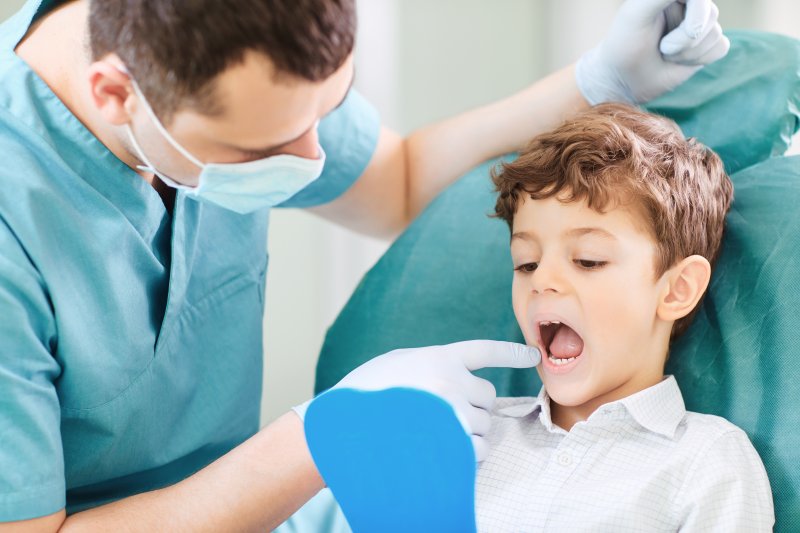Dr. Maggie Davis' Blog
4 Facts Every Parent Should Know About Their Baby’s Teeth
January 30, 2021

From birth plans to sleeping schedules, there is a lot that goes into caring for the newest member of your family. And when you lock eyes with them and see their little, gummy smile for the first time, you know all the sleepless nights and endless preparation is worth it. Keeping their baby teeth in pristine condition throughout the years comes with its own set of do’s and don’ts, which many parents often forget. Fortunately, you can keep reading for four must-know tips to prevent that job from becoming overwhelming!
(more…)Is It Possible for Kids to Get Gum Disease?
December 17, 2020

Gum disease is a serious dental issue that affects roughly 50% of American adults. If neglected, the harmful bacteria associated with this infection can significantly damage the soft tissue and bone underneath, resulting in everything from tooth loss to overall health concerns. But did you know that kids can get it too? Read on to learn the common causes of gum disease in children, symptoms to look out for, and treatment options.
(more…)Are Dental X-Rays Safe for Kids?
October 13, 2020

As a parent, you’re always considering your child’s health and safety. So when your dentist recommends that your son or daughter has dental X-rays taken, you may be wondering just how necessary and safe this step is. Thankfully, you have nothing to fear! Thanks to advancements in dental technology, x-rays are now taken digitally and are safer than ever before! Here’s what you need to know about this important tool for keeping your little one’s smile healthy as it grows.
(more…)Will Nail Biting Hurt My Child’s Teeth?
September 24, 2020

Does your child engage in nail biting when they are nervous or bored? Then you are not alone. In fact, 30% to 60% of school-aged children and 20% of adolescents engage in this behavior. Initially, it may seem like nothing more than a harmless “phase.” However, this destructive habit can lead to a number of dental issues that negatively affect your favorite smile. Read on for how it can impact your child’s oral health, five tips for kicking the habit, and how their dentist can help.
(more…)Homeschooling and Oral Health: What to Teach Your Child
August 14, 2020

Whether you were expecting to homeschool your child or COVID-19 led you to make the decision to keep them at home this year, you’re probably looking for unique ways to incorporate oral health for kids into their curriculum. Even if your child comes downstairs each morning in their pajamas to learn, it’s important they not only practice a good oral hygiene routine before they start the day but also, learn about what can happen to their teeth when they don’t. To help them get excited about brushing and flossing, check out these available resources you can begin teaching today.
(more…)How Breastfeeding Impacts Your Child’s Oral Health
May 5, 2020
Breastfeeding has proven to have countless benefits for both mother and baby. Many people are aware that it protects against allergies and eczema, reduces the risk of viruses and certain infections, and can even lessen the threat of SIDS. But did you know that breastfeeding can also affect the oral health of your baby?
Delivers Essential Nutrients
Breast milk provides children with the essential nutrients they need to grow and thrive. Each of these nutrients is important for maintaining healthy gums and teeth, once they erupt. Breast milk contains fatty acids which reduce inflammation, proteins which help build strong jaw muscles, and vitamins needed for good overall oral health.
Aids in Bite Alignment
In a recent study, researchers discovered that babies who were breastfed exclusively for the first six months of their life were 72 percent less likely to develop crooked teeth. This is primarily due to the sucking mechanism that differs between breastfed and bottle-fed babies. Breastfeeding stimulates the lower facial muscles which can help tone and strengthen the jaw. This can reduce the risk of bite alignment as the child grows.
Reduces the Risk of Tooth Decay
While any child can suffer from tooth decay, babies who are bottle-fed are more likely to develop cavities. Baby bottle tooth decay can occur due to frequent, prolonged exposure of a baby’s teeth to beverages that contain sugar; for example, when a baby is put to sleep with a bottle. Breastfeeding minimizes the risk of baby bottle tooth decay as most babies who breastfeed are not usually exposed to milk for as long of a period as bottle-fed babies.
Breastfeeding can also ward off cavities in other ways. Breast milk contains antibodies that help fight back against harmful bacteria in the mouth. This antibiotic effect of antibodies helps to counteract the effect of tooth decay to help children maintain a healthy smile. This is especially important for children who have certain genetic defects or health conditions that cause soft enamel, making them more prone to tooth decay.
Tips for Breastfeeding Moms
Many pediatric dental specialists recommend starting good oral hygiene care before your baby’s first tooth even appears. While you might not be able to see your little one’s teeth, they’re still there. In fact, teeth begin to form as early as the second trimester of pregnancy. Most babies will have 20 primary teeth when they are born, some of which are fully developed in the jaw.
To help care for your child’s smile, follow these simple tips:
- Gently run a clean, damp washcloth over your baby’s gums after each feeding to remove harmful bacteria.
- Once teeth emerge, use a small amount of water, an infant toothbrush, and a dot of fluoride toothpaste (about the size of a grain of rice) to brush your child’s teeth.
- When teeth begin to touch, start flossing between them.
- Start teaching your child to spit while brushing around age two. Once your child has reached age three, upgrade to a pea-sized amount of fluoride toothpaste.
- Schedule a visit to a kids’ dentist by the time your child reaches their first birthday. Your pediatric dentist will perform a basic exam and explain proper brushing and flossing techniques.
- Ask your dentist about applying a topical fluoride if your child is at high risk for tooth decay.
- Promote good nutrition by limiting the number of sugary foods and beverages in your child’s diet. Candy, juice, and other sugary foods and drinks can erode enamel and contribute to cavities.
Breastfeeding and Good Oral Health
While the health of your child is your first priority, it is also important to take time for yourself. Motherhood is a big responsibility but don’t neglect your own health, including your oral health. If you have any more questions about breastfeeding and its connection to oral health, contact the pediatric dentists at Dr. Maggie Davis & Associates in Palm Harbor, Florida today to learn more.
Saliva and Your Child’s Oral Health
April 23, 2020
Your child’s oral health is very important. There’s a lot going on in their little mouths that need to be taken care of from the time they are born. Did you know that the saliva in your child’s mouth provides them with a “natural bath” until it’s time to brush their teeth? It’s true. Think of it as a gift from nature in taking care of your teeth, because it’s the same for adults too. Let’s look at some ways to keep this saliva secretion healthy!
How Saliva Improves a Child’s Oral Health
Saliva is the clear liquid that a mouth produces from salivary glands. These are located all around the mouth and work constantly to produce a healthy amount of saliva or “spit,” as it’s sometimes called. Made up mostly of water, overall each day your body can make around two pints of the secretion. It’s a little icky to think of, but that massive amount of saliva is working hard to make your mouth the healthiest it can be.
Even though it is mainly water, saliva also contains electrolytes and has other antibacterial properties that aid in keeping your mouth healthy. This is important for your child’s overall wellness.
Saliva Helps to Break Down Food Particles
One of the biggest jobs of saliva is to break down food particles. It would be very difficult to eat just about anything without saliva helping out the process. Along with your child’s teeth and tongue, saliva gets the food nice and moist to make sure it goes down their throat with ease.
After your child eats, it’s natural that some of the food particles will remain in their teeth. The saliva gradually washes away and breaks down those food particles, so they don’t stay embedded between the teeth and in the gums before they floss or brush.
Saliva also reduces the harmful bacteria that may remain in the mouth. That’s due to the enzymes in the saliva that can help reduce the amount of times your child may become ill. So when you think of it, saliva is really a superhero solution in your child’s mouth.
A Pediatric Dentist Loves What Saliva Does
Proper saliva production can keep teeth and gums healthy. It protects the teeth by acting as a natural cleaning agent to bathe the teeth between brushing sessions, morning and night. Pediatric dentists just love what saliva can do for your child’s teeth because it helps prevent problems, like cavities, from forming over the long run. Saliva truly does a wonder of good for your mouth.
Keep in mind that it’s still absolutely vital to encourage and make sure that your child brushes their teeth twice a day. More than likely, you will have to supervise your child and assist in proper brushing until they are around the age of eight. Make sure they brush their teeth for a least two minutes per session. Make it a fun activity for your child if it’s something they don’t like to do very much. Play or sing a fun song for them, let them pick out a toothbrush with colors or characters they like, and tell them how proud you are after they do a great job at cleaning their teeth.
Ways to Improve Saliva Production in Your Child
Your pediatric dentist will be able to tell if your child’s mouth is producing enough saliva by doing a regular exam. Some tips to make sure that your child’s mouth is properly hydrated is by making sure they get enough water each day. It can also help to let your older children chew sugar-free gum or have a mint after a meal to enhance the activity of their saliva.
If you have questions about your child’s oral health, it’s important to find the right pediatric dentist for your family. At Maggie Davis & Associates, one of our goals is to help your kids “grow up smiling” by helping them develop a healthy, beautiful cavity-free smile. Contact us today to make an appointment for your child’s next visit!
How to Be Part of Our Cavity-Free Club
March 3, 2020
Want to help your child become a member of the Cavity-Free Club? It takes just a few minutes a day to establish a good oral hygiene routine. Read on to learn more!
Start Early
Many parents are unsure of the best time to start brushing and flossing their child’s teeth. What many parents don’t know is that they should begin good oral care before any teeth emerge. The AAP recommends wiping a baby’s gums with a baby toothbrush or soft washcloth after feeding. Once the first tooth erupts, parents should start brushing for two minutes two times a day using a soft-bristled toothbrush and a pea-sized dab of toothpaste.
When it comes to flossing, it’s best to start when the child has teeth that are in contact with one another. This usually occurs around age two or three. When teeth come in contact with one another, food particles can become lodged in the space in between. It’s important to teach them to upkeep their brushing and flossing every day, morning and night.
Brush and Floss
Brushing and flossing are the foundation for good oral health. Children should brush their teeth with the help of a parent starting from infancy. Only a small dab of toothpaste is needed for young children. Use a fluoride-free toothpaste until your child is old enough to spit it out, then you can switch to fluoride toothpaste as they get older. Show your child how to brush each tooth, front and back, along with the gums, and on the tongue. If you are not sure of the correct technique, ask your Palm Harbor pediatric dentist to show you.
By the time that your child is 7 or 8 years old, they may be ready to start brushing on their own. This is also the time to switch to a larger-sized toothbrush. When brushing, set a timer for two minutes to ensure that your child does not stop brushing before an adequate amount of time has passed. Also, teach your child to floss at least once a day. If you find traditional floss difficult to use, try floss equipped with a handle to make it easier. Don’t forget to replace your child’s toothbrush every three to six months.
Eat Healthy
Diet plays a major role in the health of teeth and gums. Children who consume a high sugar diet are at a much higher risk of developing tooth decay. Limit the amount of soda, juice, sweetened drinks, and other sugary treats that your child has. It is also a good idea to limit snacking between meals. When your child does have sugar, have them brush afterward.
Children over the age of two should drink mostly water to stay hydrated. Water is not only healthy for children but also helps to wash away food debris and dilute acids that can weaken enamel. Provide your child with a balanced diet containing fresh fruits and veggies, low-fat dairy, nuts, and seeds. Older children can benefit from chewing sugarless gum with xylitol, which can help stimulate the salivary glands, strengthen the jaw, wash away bits of food, freshen breath, and balance the acids that cause decay.
Visit a Pediatric Dentist
As soon as teeth emerge, cavities can develop. That is why it’s important for your child to visit a pediatric dentist at least every six months. At Dr. Maggie Davis & Associates, we offer a wide range of preventative services to keep your child’s smile gleaming. Regular visits to a pediatric dentist will also help ensure that your child is part of our Cavity-Free Club month after month. Call us today to schedule your child’s first appointment and get your child one step closer to a cavity-free life!
Not So Sweet Valentine Treats
February 6, 2020
Why You Should Limit Your Sweet Valentine Treats
Sweet treats have a lot of sugar and calories, while not containing a high nutritious content. Eating a lot of these treats can lead to weight gain and potential problems in the future, such as diabetes. They can also make a child feel sluggish or cause them to have problems sleeping. The other primary reason why you want to limit sweet Valentine treats is that the sugar can lead to cavities in a child. This is why may dentists for children advise you to limit your child’s sugar intake during any holiday, but especially ones that are surrounded by candy, like Halloween, and Easter.
Some Not So Sweet Valentine Treats to Consume
As a parent, you want to make holidays fun for your child. For many households, this includes making special treats for the holidays. Many families make Valentine’s Day cookies, cupcakes, cakes, or serve Valentine’s Day candies to help celebrate the day. If you want to serve some treats for the occasion, there are many not so sweet or less sweet treats that you can create for the occasion. Fruit is always a great option. You can make a fun fruit salad featuring all pink, purple, and red treats. Or, you can use a cookie cutter, and cut small hearts into cantaloupe, honeydew, or pineapple. Dipping items in chocolate has less sugar than a solid candy bar, so consider making chocolate dipped strawberries or pretzels. You can then use sprinkles to add color and texture.You can also use colored food drops to regular applesauce, yogurt, or milk, creating a fun pink Valentine’s treat. Lastly, you can make red or pink fruit smoothies using berries to create a healthy Valentine’s day snack.
The Worst Types of Valentine Treats for Your Teeth
There is nothing wrong with indulging in a sweet treat here or there, especially on a holiday. However, not all sweet treats are the same. Items that are hard, sticky, or chewy, such as caramel candy apples, lollipops, or sugary gummy candies are worse for your teeth than an item such as a solid chocolate bar. Hard items can cause stress fractures to teeth, while sticky items can stick to the teeth and can be difficult to remove. This not only increases the risk of cavities, but eating sweets like lollipops can leave sugar on your child’s teeth for a prolonged period of time can wear down their enamel.
What You Can Do After Consuming Valentine Treats
If you and your child have consumed a Valentine treat, you will want to help limit the risk to your teeth. If you are out and about, try drinking a glass of water or chewing on a stick of sugar-free gum, if your child is old enough. This can also increase saliva in the mouth, which helps to fight bacteria. Once you are home, be sure to help your child brush their teeth well and floss, especially after eating sticky or gummy treats, as these can get lodged in hard to reach areas and even along the gumlines.
Limiting your child’s sweets and offering up some not so sweet Valentine treats is only one of the steps that you need to take to help protect your child’s teeth. Visiting a pediatric dentist routinely is essential to your child’s oral and dental health. If you’re in the market for a new pediatric dentist near you, visit Dr. Maggie Davis! Whether your child needs to be seen for a routine six-month dental appointment, or if they are experiencing pain and may have a cavity, we can help. Contact us and book your appointment with us today!
The Importance of Calcium In Oral Health
January 7, 2020
Dairy Is The Way
This should be quite obvious but it is quite important, especially if your children are at a younger age. This need for milk-based products like yogurt, cheese, custard, and regular milk is extremely important during the formative early years that your child’s bones are developing. From a few months old to three years, you should regularly be incorporating dairy into their diets and getting about 200 to 300 mg a day for the first year, with an increase of up to 700mg a day by the end of the first three years.
Add Meats and Leafy Greens
There’s nothing better than bok choy, cabbage, spinach, brussel sprouts, and broccoli for your child’s diet. Besides the obvious plethora of nutritional benefits that can be derived from these plants, they are also full of calcium nutrients that are ideal for your growing child. These are also a great and easy addition to any lunch and dinner plate. Try adding fish as the major protein ingredient for lunch and dinner. Fresh salmon is ideal but canned tuna and sardines are also excellent sources of calcium if you are looking to make a quick lunch.
Snacking and Munching
Put down the processed foods like cookies and chips and focus on calcium delivering alternatives like brazil nuts and almonds. Snack time is a big opportunity to get calcium into your children’s diet. Instead of munching on a sugary snack, you can make trail mixes for them that include ingredients like almonds mixed raisins, you can even throw some milk chocolate pieces in the mix too!
What To Drink
By reducing soft-drink intake in your children, like juice, and having them drink water or a dairy-based drink instead, you can easily add to their recommended calcium intake. Start practicing this in the home as well by limiting your own consumption of soft drinks, caffeine, and alcohol. The long term benefits you obtain will far outweigh the short term gratification you get from a craving. Plus, you’ll be setting a good example for them early on.
Dietary Restrictions
Calcium intake can be a little different if you have some dietary restrictions, however, it is still possible to get a healthy amount of calcium even if you do have to make concessions with your child’s diet. Non-dairy foods like oranges, figs, sweet potatoes, and most grains are high in calcium.
Lactose Intolerance
Forcing your child to consume regular dairy products when they are lactose intolerant can result in diarrhea and severe cramps. Instead, try incorporating calcium-fortified soy or almond milk into their diet. Additionally, you can increase the intake of those leafy greens and meats in order to compensate for the lack of calcium intake through dairy products.
Incorporating A Vegan Diet
In the past, there weren’t many options for vegans to have access to much calcium intake due to dairy restrictions. These days, however, there are a plethora of dietary solutions that can be substituted in. For example, you can replace the fish in some of your meals with ingredients like Tofu or Tempeh. These meat substitutions are an excellent source of calcium and are low in saturated fats. Even if you don’t commit to a vegan diet, it can be healthy for your family to have a vegan meal a few times a week.
As you can see, there are several ways of incorporating calcium into your child’s diet whether they have food restrictions or not. Additionally, educating them on the importance of their food consumption and how it affects their development can have a marked impact later on in their life and can lead to a lifetime of healthy calcium consumption. For more information about how you can improve the oral health of your child, contact us today.
